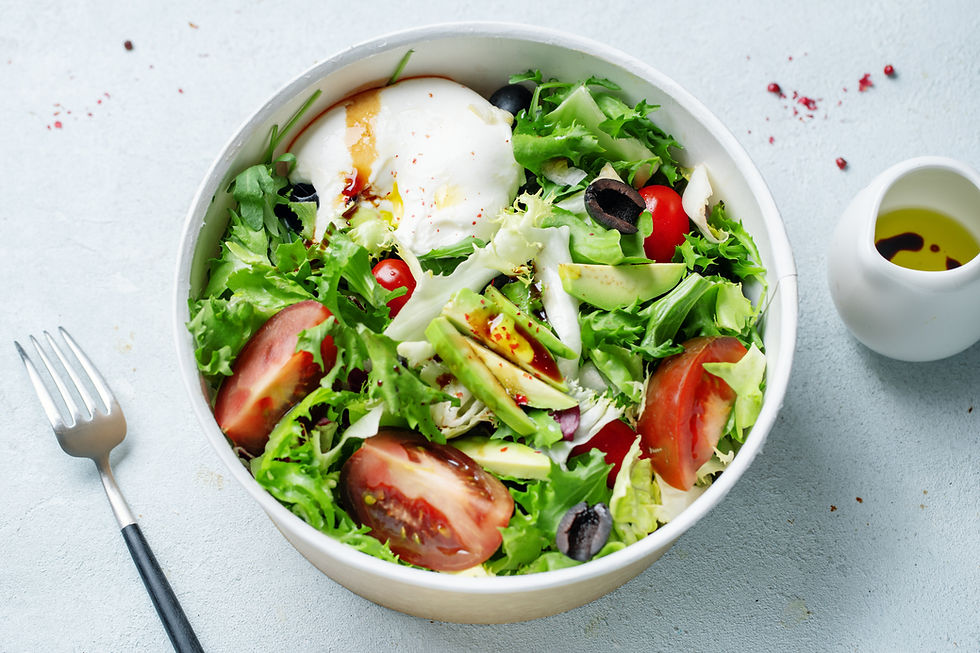Understanding the Role of Fibre in Gut Health: Benefits, Types, and Easy Ways to Add Fibre to Your Diet
- Stephanie
- Nov 9, 2024
- 4 min read
Updated: Feb 8
Our gut is home to trillions of bacteria known as the gut microbiome. These bacteria play vital roles in digestion, vitamin production, immune regulation, and even mood enhancement.
A thriving gut microbiome is diverse and resilient. When its balance is disrupted, you might struggle with bloating, indigestion, and other uncomfortable symptoms.
In this blog, we will explore fibre, its benefits for gut health, the types of fibre, and practical ways to incorporate more fibre into your diet.
What Is Fibre?
Fibre is a type of carbohydrate that our bodies can’t completely break down or absorb. Instead, it travels through our digestive system mostly intact, which is essential for gut health.
Fibre helps maintain healthy digestion and has several additional health benefits, including better blood sugar control, lower cholesterol levels, and weight management.
The Different Types of Fibre

Fibre can be divided into two main types, each serving unique purposes for our digestive health:
Soluble Fibre: This type dissolves in water, forming a gel-like substance. It helps lower blood sugar and cholesterol levels. Foods rich in soluble fibre include oats, beans, lentils, apples, and oranges. For example, a cup of cooked oatmeal may contain around 4 grams of soluble fibre.
Insoluble Fibre: This type does not dissolve in water, adding bulk to stool and helping to prevent constipation. It's abundant in whole grains, nuts, and the skins of many fruits and vegetables. For instance, a medium-sized apple with skin adds about 4 grams of insoluble fibre to your diet.
It is crucial to include both types of fibre in your diet to promote a healthy gut. Each type functions uniquely to aid digestion, maintain a balanced gut microbiome, and enhance nutrient absorption efficiency.
How Fibre Benefits Gut Health
Let's explore the incredible benefits that fibre provides for your digestive system:
1. Fibre Feeds Good Bacteria
When we eat fibre, especially soluble fibre, it acts as a prebiotic, serving as fuel for beneficial bacteria in the large intestine. Through fermentation, these bacteria break down the fibre, producing short-chain fatty acids like butyrate. These fatty acids nourish the cells lining our gut, reduce inflammation, and support a balanced microbiome. Research also suggests that butyrate may protect against certain gut disorders and even reduce the risk of colon cancer.
2. Fibre Supports Regular Digestion
Insoluble fibre, which doesn’t dissolve in water, adds bulk to the stool, helping food pass efficiently through the digestive tract. This supports regular bowel movements and helps prevent constipation, keeping everything moving smoothly.

3. Fibre Balances Blood Sugar and Cholesterol
Fibre, particularly soluble fibre, can slow down the absorption of sugar, helping to prevent rapid spikes in blood sugar levels. This is crucial for people managing diabetes or insulin resistance. Moreover, soluble fibre binds to cholesterol, assisting in its removal from the body and supporting heart health. Therefore, the benefits of fibre go far beyond just digestive wellbeing.
4. Fibre Helps with Satiety and Weight Management
High-fibre foods are filling and promote a sense of fullness, which can help with portion control and support healthier weight management. Since fibre-rich foods take longer to chew and digest, they may also reduce cravings for unhealthy snacks.
Easy Ways to Get More Fibre
The current recommendation for adults in the UK is 30 grams of fibre daily. However, the average intake is only about 20 grams, suggesting that many can improve their diets.
If you are wondering how to boost your fibre intake without drastic changes, here are some simple strategies:
1. Add Whole Grains
Opt for whole grain versions of staple foods when possible. Choices like brown rice, whole grain bread, and whole grain pasta retain the bran and germ, providing more fibre than refined options. A slice of whole grain bread has about 2 to 3 grams of fibre, while white bread contains less than 1 gram.
2. Choose Fibre-Rich Fruits and Vegetables
Fruits and vegetables are fantastic sources of fibre. Aim to include various types and colours in your meals. Berries, apples, pears, carrots, and broccoli are particularly high in fibre. For instance, one cup of raspberries contains 8 grams of fibre.

3. Include Legumes and Beans
Legumes, like lentils, chickpeas, and beans, offer a rich source of fibre. They can be easily added to soups, salads, and main dishes. For example, one cup of cooked lentils provides around 15 grams of fibre, making it an excellent choice.
4. Don’t Forget Nuts and Seeds
Almonds, chia seeds, and flaxseeds are all fibre-rich and can be easily added to smoothies, yoghurt, or salads. They are also great sources of healthy fats and provide a satisfying crunch to your meals.
5. Snack Smart
Replace highly processed snacks with fibre-rich options like fresh fruit, nuts, or even a handful of popcorn. These healthier choices are not only satisfying but also beneficial for your digestive health.
One tip, though
As you start increasing fibre in your diet, do so gradually. It's best to combine fibre intake with plenty of water. Sudden increases in fibre can lead to gas and bloating, so start small and build up your consumption to let your digestive system adjust.

Key takeaways
The gut microbiome significantly influences our overall health, and fibre plays a vital role in supporting this balance. By learning about different fibre types and their digestive benefits, you can make more informed food choices.
Incorporating fibre-rich foods regulates digestion, nourishes gut bacteria, supports a healthy weight, and even improves heart health.
As you go through your day, I encourage you to consider how you can gradually incorporate more fibre-rich foods into your meals. Start with small, manageable changes, such as adding a serving of vegetables to your lunch or swapping white bread for whole grain bread.